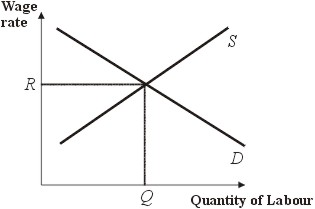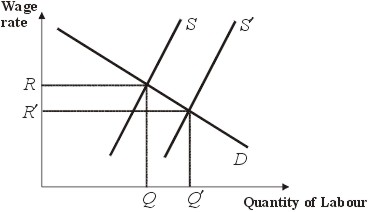|
The Labour Market |
The determination of wage rates |
|
The labour market is segmented. What this means is that people have different skills and abilities and do different jobs. Obviously, different jobs attract different wage rates. A computer programmer is paid more per hour than a teacher.
|
|
|
The wage rate is the term we use to refer to the price that an hour of labour is charged at.
|
|
|
People seeking work in a given industry constitute the supply of labour. Firms in the industry require people to work for them, and this results in a demand for labour. Hence, there is a labour market, and the interaction of supply and demand in the labour market determines the wage rate.
|
|
|
Here we will assume that the supply of labour results in an upwardly sloping demand curve. As the wage rate increases, the number of people willing to work for that wage rate also increases. Some people with transferable skills might switch from one industry to another. For example, if wage rates for teachers increases, some accountants might switch from accountancy to teaching! The higher wage rates might also attract some people to work overtime. Finally, there might be people who have, for instance, taken early retirement. However, an increase in the wage rate attracts them out of retirement.
|
|
|
In practice, the supply of labour may not be so simple as this — however, at this stage we seek to concentrate on the basic idea of the labour market as arising from the interaction of the supply and demand for labour, so we keep it simple, and treat the supply and demand curves for labour as straight-line graphs sloping upwards and downwards respectively, as if units of labour were like other normal goods!
As just indicated, in this simplified model, we also expect demand for labour to be a downward sloping relationship. As the wage rate increases, this results in increased factor costs for firms in the industry, so they find it harder to make a profit, and hence demand for labour decreases.
|
|
|
The interaction of supply and demand for labour results in the determination of the wage rate.
|
|

|
|
|
Determination of the wage rate for a given industry. This is the price charged per unit of labour and results from the interaction of supply and demand for labour.
|
|
|
Shifts in the supply and demand for labour will result in changes in the wage rate.
|
|
|
For example, lawyers may be able to charge big fees to their clients. This could attract graduate students to undertake law conversion courses. Other things being equal, the result is a shift outwards in the supply of lawyers. This should result in a fall in the wage rate for lawyers.
|
|

|
|
|
An increase in the supply of labour to a given industry results in a fall in the wage rate from R to R' and an increase in the quantity of labour supplied from Q to Q'.
|
|